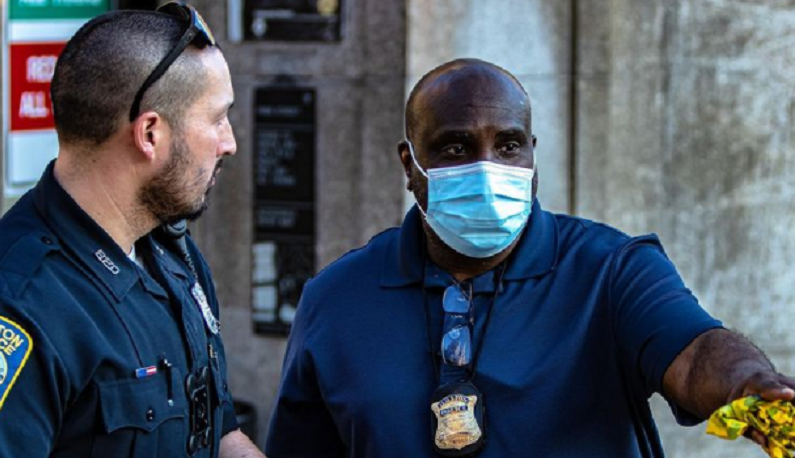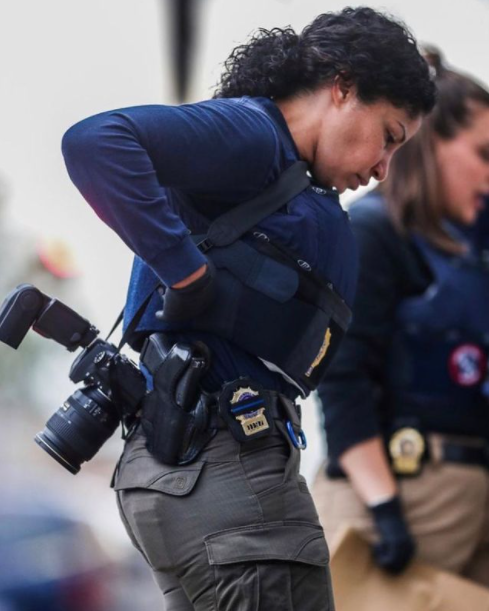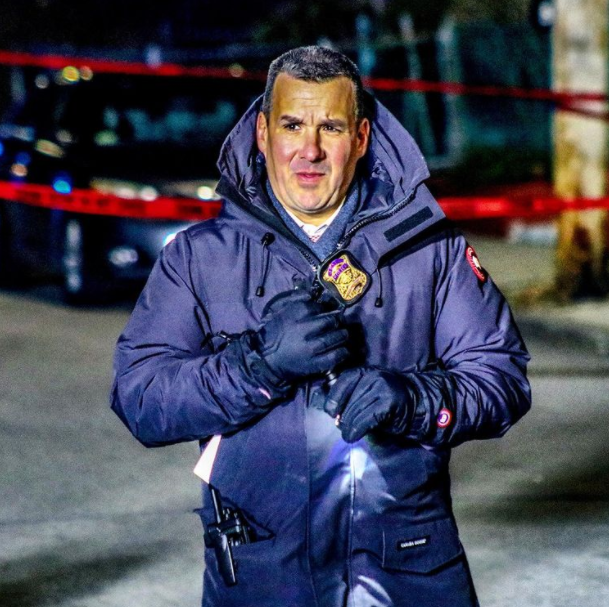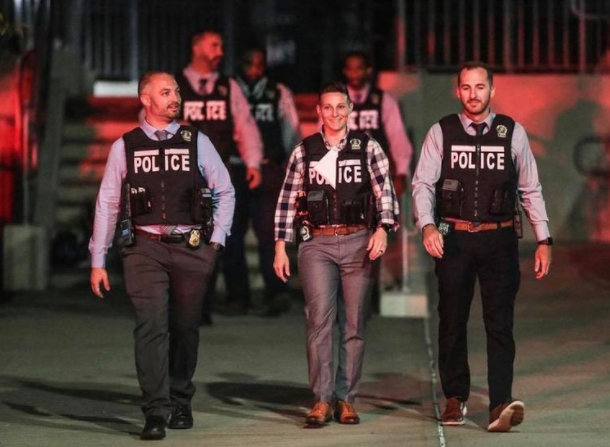
One of the myriad features in the law enforcement infrastructure, and a vital girder in its framework, is the police detective. Making the grade to detective usually means one has achieved years on the job, tons of street knowledge, a bevy of contacts in the community, and keen senses to guide investigations and solidify capers with arrests, making them beacons for lesser-experienced cops to draw upon wells of wisdom and vast experience.
Historically operating in business attire, contemporary police detectives may don slacks, topped with what is known as “soft uniforms” consisting of an agency-issued polo shirt embroidered with the agency’s name, the detective’s name, and an iconic shield or star emblem sewn on. This garb is seamed in the middle by a belt which has the duty of retaining a service firearm, a detective’s badge, a set of handcuffs, a handheld radio pouched in a belt-clipped cradle, all empowered by a tin badge.

(Photo courtesy of Greatest Detectives.)
The badge is typically gold, indicating a classed rank of achievement otherwise known as “making the grade.” Although not ranked with oversight capacity such as that of a detective sergeant’s chevrons or a lieutenant’s bar or a captain’s set of bars or higher executive ranks charged with overall administration, police detectives are considered rungs above patrol cops, respectfully.
With the pictured painted, recognizing police detectives on the streets, particularly at crime scenes, is relatively easy. The man or woman dressed as described above will have a concentrated expression of discernment, consternation, usually punctuated by furrowed brows—figuring things out and reconstructing events.

(Photo courtesy of the Boston Police Detectives Union.)
Conversely, if modus operandi and details at the crime scene appear unambiguously familiar, the detective likely wears the look of confidence, of someone who knows something, perhaps exactly who is the causation of the latest depravity and destruction—next stop: Potential suspect.
Kinda like the Farmer’s Insurance advertising campaign slogan, “We know a thing or two because we’ve seen a thing or two.” Detectives know quite a bit, making them successful in running down leads, homing in on the whereabouts of bad guys, and clearing cases.
Police detectives are assigned their caseloads on the daily, with Mondays plunking down a motherload of all-new cases from weekend incidents. What patrol officers respond to and document is a distillation of facts recorded on police reports which, when not real-time closed with an arrest, is the responsibility of the assigned detective to further develop and wrap up. In the event circumstances over time amount to a stand-still, the drawer containing cold case files gets a new manila. For the latter cases lacking traction to continue pursuing, the cases deemed at impasse are why agencies formed “cold case detectives.”
Cold case investigators have an uncanny ability to sift through historical affidavits, re-establish witness lists, reexamine evidence, ponder ideations which may not have had enough mindset at the time of the crime, and freshly lube the gumshoe engine, giving it all another go. This cycle repeats as the rotation of newly selected detectives making the grade merge among the mix of investigators. “Fresh eyes” concepts always apply.

(Photo courtesy of Greatest Detectives.)
Imagine cold case victims (or their loved ones, if the actual crime victim is no longer with us) realizing justice seekers are still digging for truth and clawing for closure…on behalf of many who thought they’d never see proverbial closure.
Although not as commonly seen as beat cops, detectives maintain correspondence with crime victims and their families whether the case is still being investigated, about to go to trial, or concluded. Bonds are formed between police investigators and bona fide victims (and their families when it involves loss of life such as a homicide). Even lesser circumstances during which detectives portray savvy are indelible.
One throwback episode I recall well involved a neighboring agency’s police detective showing much younger police personnel simple feats with significant flair resulting in unorthodox arrest measures (only one, really) and officer safety principles.
At a Tampa Bay Bucs football game in which tens of thousands were blanketing fields reserved for tailgating, one heavily intoxicated male decided to mouth off to people in nearby surroundings, including youngsters excitedly prepped to see their fave football stars.
Police officers in proximity got wind of the belligerent and approached, offering friendly words of advice. His bleepity-bleep response earned him an ejection from the premises. But he didn’t wanna go. The diplomatic guidance of cops grew thin…meaning police attention grew thicker.
One final warning to vacate was given. This 6’-5” lanky, sweaty guy stomped and planted his feet, while also balling his hands into fists. In short, it was game on: He qualified for a one-way trip to county jail.
Trying to effect the arrest, though, became twisted when the suspect swiftly opened his car door. At least five uniformed officers enveloped him and prevented him from entering the car’s compartment; any LEO in this circumstance would immediately figure the guy is going for a weapon or attempting to flee—maybe both.
The tussle to effect arrest in the open-door wedge was less than ideal. I stood as a fifth wheel, on the periphery of police officers preventing this guy from getting in; as I homed in to restrain the slippery guy with handcuffs, I saw a detective from a larger city police department walk up. His facial expression reminded me of the notorious one worn by Clint Eastwood in all his don’t-mess-with-me movie roles.
With a bushy white mustache and a matching pate of thinned hair, this detective sergeant (I later learned was supervising uniformed personnel from his agency, working the game) meekly reached down and folded one of the flailing suspect’s legs behind him —heel touching his buttocks— leaving him absolutely imbalanced. It was suddenly quiet, kinda surreal. Definitely surreal.
The suspect’s brain froze with confusion, it seemed. He stopped resisting. His litany of obscenities ceased. He looked around sort of embarrassed (gobs of football game spectators watched this play out). Handcuffs went on securely. It was over, just like that.
The football fans started to pitter-patter clap, then whoop-whoop, followed by an amateur chorus of the “Bad Boys” tune from the TV series COPS.
All of us, about five uniformed cops from different police agencies working in tandem, stood there in amusement. It was one of those things whereby you never would have thought to do something a certain way…until you see it done a certain way. From that moment on, I filed that maneuver away.
Years later, I became a field training officer (FTO) and shared this episodic experience with each of the police trainees assigned to me. I figured: Give them the lesson now, so that they’d be ready to employ the forever-after trick which became known as “getting a leg up.”
Everyone gets a kick out of that simple remedy to a resisting suspect. Like we said, detectives know a thing or two…
And that seasoned detective never said a word about the whole ordeal. Just walked away as meekly as when he approached, reached down, and folded the bad guy like a jackknifed tractor-trailer. A dignified stance instead of opting for limelight or sensational scene.
Like I said, this was a bygone-era happenstance; nowadays, with the defund-the-police-induced exodus, police staffing has shrunk a great deal. It is a bittersweet understanding regarding sensei detectives no longer feeling grounded, as the police defunders and abolitionists continued to bullhorn-blast hatred. Departing the biz is not only about respective cops but also the welfare and sanctity of their loved ones.
Well before the contemporary anti-police climate, detectives investigating crime scenes were equally instrumental indoors, lending calculus to cases until closed (or exhausted for the time being aka cold).
When I was on light duty after completing cancer treatments and relegated to behind-a-desk duties, I slid my way in many morning roll calls held by the Criminal Investigations Division detectives. Boy, was that fulfilling!
Not only did I get to chomp on Danish and bagels chased by fresh-brewed coffee each a.m. briefing, I was able to glean how these investigatory minds analyze cases beyond what the report-writing beat cop composed under typically time-pressured constraints. The critical-thinking volleys were admirable, offering waves of out-of-the-box mindsets, considering all angles and options to solve matters on behalf of victims.
Sitting in on detective briefings each morning was akin to being compensated to dissect criminology and psychology materials, for free, with breakfast. Crime scene techs (civilians in my department) were also always present at the table, so I got even more fascinated with the forensics side, far beyond what the academy entailed years prior. Plus our crime scene staff offered gems regarding the latest findings in police science and how the courts expect evidentiary integrity for judicial consideration.
Detective Division roll calls became a daily mini-academy, equipping me with strategies and techniques I would eventually use and pay forward as a police cadet trainer, hoping the rookies would also carry it forward.
This encouraged me to submit apps to police administration, indicating my desire to attend police academies and law enforcement agencies teaching courses in advanced this and advanced that. Each of these advanced classes go beyond what the basic law enforcement training (BLET) offers at the starting point of a police academy providing core principles and procedures.
My gumshoe duty boots got adhered to a pursuit as a police detective. For a spell, it stuck with me.
But my mainstay midnight-shift slot as a patrol cop had me thoroughly glued to working the streets with my uniformed cohorts. Ultimately, I took all lessons learned from a cadre of detectives back to the street beat. Becoming a field training officer was my way of stitching together the detective role with the street cop experience, molding patrol officers to sustain and survive the ever-changing environments in which they operate. As an FTO, I found a happy middle-ground for the remainder of my police career.
Like in any industry or profession, focus on more experienced personnel is a gem of an idea. With the exodus going on in liberal-bent jurisdictions condemning cops, many highly-seasoned and valuable assets are retiring as detectives, honoring self-respect and closing the book with dignity derived from stellar police service. I vouch for many…